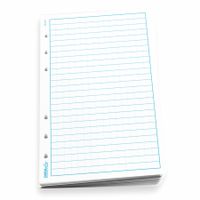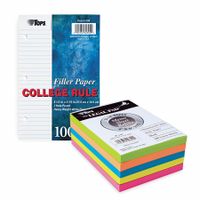Call +(254) 703 030 000 / 751 483 999 / 721 704 777
- Home
- Office Supplies
- Office Paper Notebooks
- Loose Leaf Paper
.....Read More
Frequently Asked Questions
What is loose-leaf paper used for?
Loose-leaf paper is used for a variety of purposes, primarily in educational, professional, and personal settings. It is commonly found in binders, allowing for easy organization and rearrangement of notes, documents, and other written materials. In educational settings, students use loose-leaf paper for taking notes, completing assignments, and organizing study materials. The ability to add or remove pages makes it ideal for creating customized notebooks or study guides.
In professional environments, loose-leaf paper is used for maintaining records, compiling reports, and organizing project documentation. It allows for flexibility in updating information without the need to rewrite entire documents. Loose-leaf paper is also popular for creating manuals or handbooks, as pages can be easily updated or replaced as needed.
For personal use, individuals often use loose-leaf paper for journaling, sketching, or maintaining planners. The customizable nature of loose-leaf paper makes it suitable for scrapbooking or creating personalized recipe books. Additionally, it is often used for creative projects, such as designing planners or bullet journals, where users can add or remove pages to suit their needs.
Overall, loose-leaf paper is valued for its versatility, allowing users to organize and manage information efficiently. Its adaptability makes it a preferred choice for those who require a flexible and customizable approach to handling written materials.
How is loose-leaf paper different from regular paper?
Loose-leaf paper is distinct from regular paper primarily in its design and intended use. Loose-leaf paper is typically pre-punched with holes along one side, allowing it to be easily inserted into binders or folders with rings. This feature makes it highly versatile for organizing and rearranging documents, notes, or assignments. It is often used in educational and professional settings where flexibility and organization are key.
In contrast, regular paper, such as printer or notebook paper, usually lacks these pre-punched holes and is often bound in a fixed format, like a notebook or a ream for printing. Regular paper is generally used for printing, writing, or drawing and is not designed for easy removal or rearrangement.
Loose-leaf paper is often sold in packs and can come in various sizes, such as letter or A4, and different rulings, like college-ruled or wide-ruled, to suit different needs. Regular paper also comes in various sizes and types, including plain, lined, or graph, but is typically used in a more static format.
The choice between loose-leaf and regular paper depends on the user's needs for flexibility, organization, and the specific application, such as note-taking, document preparation, or creative projects.
What sizes does loose-leaf paper come in?
Loose-leaf paper is available in various sizes to accommodate different needs and preferences. The most common sizes include:
1. **Letter Size (8.5 x 11 inches)**: Predominantly used in the United States and Canada, this size is standard for school and office use. It fits most binders and folders designed for letter-sized documents.
2. **Legal Size (8.5 x 14 inches)**: Slightly longer than letter size, legal-sized paper is often used for legal documents and contracts. It provides extra space for detailed notes or extended writing.
3. **A4 Size (210 x 297 mm or approximately 8.27 x 11.69 inches)**: Widely used internationally, especially in Europe and other countries following the ISO 216 standard. A4 is the most common paper size for writing, printing, and office use outside North America.
4. **A5 Size (148 x 210 mm or approximately 5.83 x 8.27 inches)**: Half the size of A4, A5 is often used for personal organizers, small notebooks, and diaries. It is portable and convenient for note-taking on the go.
5. **B5 Size (176 x 250 mm or approximately 6.93 x 9.84 inches)**: Popular in Asia, B5 is used for notebooks and writing pads. It offers a balance between A4 and A5, providing ample writing space while remaining compact.
6. **Half-Letter Size (5.5 x 8.5 inches)**: Also known as statement size, this is half the size of letter paper. It is commonly used for personal planners and smaller notebooks.
These sizes cater to various applications, from academic and professional settings to personal use, ensuring that users can find the right fit for their specific requirements.
Is all loose-leaf paper waterproof?
No, not all loose-leaf paper is waterproof. Most standard loose-leaf paper is made from cellulose fibers derived from wood pulp, which is not inherently water-resistant. When exposed to water, these papers can absorb moisture, leading to warping, tearing, or disintegration.
However, there are specialized types of loose-leaf paper designed to be water-resistant or waterproof. These papers are often coated with a water-repellent substance or made from synthetic materials like polypropylene or polyester. Such papers are used in environments where exposure to moisture is likely, such as outdoor settings or industrial applications.
Waterproof papers are typically more expensive than standard paper and may have a different texture or weight. They are often marketed for specific uses, such as field notebooks for geologists, military personnel, or outdoor enthusiasts.
In summary, while standard loose-leaf paper is not waterproof, there are specialized options available for those who need water-resistant or waterproof paper.
How do you store loose-leaf paper?
To store loose-leaf paper effectively, consider the following methods:
1. **Binders**: Use three-ring binders to organize loose-leaf paper. Choose binders with durable covers and spine labels for easy identification. Use dividers to categorize subjects or topics.
2. **Folders**: Place loose-leaf paper in pocket folders. Opt for folders with fasteners to secure the paper. Label each folder for quick access.
3. **File Boxes**: Store paper in file boxes with hanging file folders. Label each folder and box for efficient retrieval. Choose boxes with lids to protect from dust.
4. **Accordion Files**: Use accordion files for portability and organization. These files expand to hold a large amount of paper and have tabs for labeling sections.
5. **Drawer Organizers**: Utilize desk drawer organizers with compartments to separate different types of paper. This method keeps paper flat and accessible.
6. **Magazine Holders**: Store paper vertically in magazine holders. This method saves space and allows for easy flipping through papers.
7. **Plastic Sleeves**: Protect important papers by placing them in plastic sleeves. Store these sleeves in binders or folders.
8. **Digital Scanning**: For long-term storage, scan papers and store them digitally. Use cloud storage or external drives for backup.
9. **Labeling**: Consistently label all storage solutions to ensure easy identification and retrieval.
10. **Regular Sorting**: Periodically sort through stored papers to discard unnecessary items and maintain organization.
By implementing these methods, you can keep loose-leaf paper organized, protected, and easily accessible.
Can loose-leaf paper be recycled?
Yes, loose-leaf paper can be recycled. Loose-leaf paper is typically made from wood pulp and is similar to other types of paper products that are commonly recycled, such as office paper, newspapers, and magazines. To recycle loose-leaf paper effectively, it is important to follow a few guidelines:
1. **Clean and Dry**: Ensure that the paper is clean and free from food stains, grease, or any other contaminants. Wet or soiled paper can disrupt the recycling process and may not be accepted by recycling facilities.
2. **Remove Non-Paper Materials**: Before recycling, remove any non-paper materials such as plastic covers, metal rings, or staples. These materials can interfere with the recycling machinery and should be disposed of separately.
3. **Sorting**: Some recycling programs require paper to be sorted by type or grade. Check with your local recycling program to see if loose-leaf paper needs to be separated from other paper products.
4. **Volume**: Collect a sufficient volume of paper to make recycling efficient. Small amounts of paper can be recycled, but larger quantities are more cost-effective for recycling facilities.
5. **Local Guidelines**: Recycling programs vary by location, so it is important to check with your local waste management authority for specific guidelines on recycling loose-leaf paper. Some areas may have specific requirements or restrictions.
By following these steps, loose-leaf paper can be effectively recycled, reducing waste and conserving resources. Recycling paper helps save trees, reduce energy consumption, and decrease landfill waste, contributing to a more sustainable environment.
Where can I buy all-weather loose-leaf paper?
You can purchase all-weather loose-leaf paper from several retailers, both online and in physical stores. Here are some options:
1. **Amazon**: A wide variety of all-weather loose-leaf paper is available on Amazon. You can find different brands, sizes, and quantities, often with customer reviews to help guide your choice.
2. **Rite in the Rain**: This brand specializes in all-weather writing products. Their website offers a range of loose-leaf paper options designed to withstand harsh conditions. You can purchase directly from their site or find their products on other online platforms.
3. **Office Supply Stores**: Chains like Staples or Office Depot may carry all-weather paper, either in-store or online. It's advisable to check their websites or call ahead to confirm availability.
4. **Outdoor and Tactical Retailers**: Stores that cater to outdoor enthusiasts, such as REI or Cabela's, often stock all-weather paper products. These can be found in the camping or tactical gear sections.
5. **Specialty Stores**: Some specialty stores that focus on military or survival gear may also carry all-weather loose-leaf paper. These can be found online or in certain locations.
6. **Etsy or eBay**: For unique or custom options, you might find sellers offering all-weather paper on platforms like Etsy or eBay.
7. **Local Bookstores or Stationery Shops**: Some independent bookstores or specialty stationery shops might carry niche products like all-weather paper. It's worth checking with local businesses.
When purchasing, consider the specific needs such as size, hole-punch configuration, and the type of weather conditions the paper will need to withstand.

